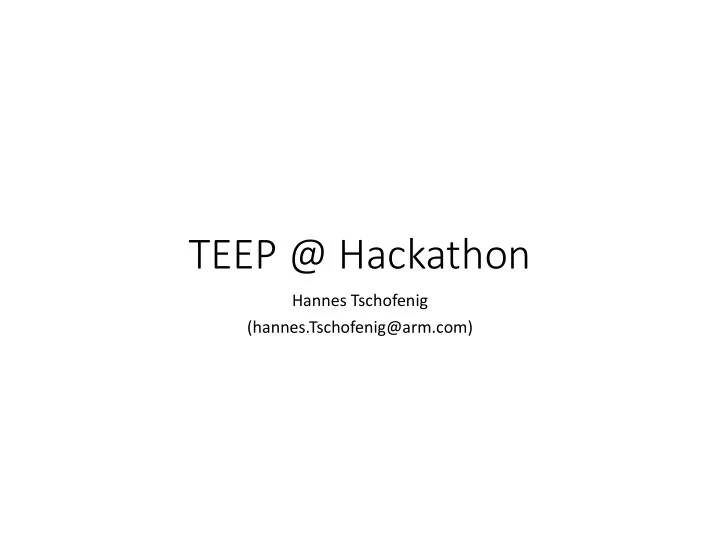

TEEP @ Hackathon Hannes Tschofenig (hannes.Tschofenig@arm.com)
Agenda • What is TEEP? • History: TEEP protocol vs. OTrP • Architecture • Goals and project ideas • TrustZone Integration
TEEP - Trusted Execution Environment Provisioning A software isolation technology The Trusted Execution Environment (TEE) concept is designed to execute applications in a protected environment that enforces that only authorized code can execute within that environment, and that any data used by such code cannot be read https://tools.ietf.org/html/draft-ietf-teep-architecture-06 or tampered with by any code outside that environment, including by a commodity operating system (if present).
Architecture The TEEP protocol installs, updates, and deletes Trusted Applications (TAs) in a device with a TEE.
TEEP Protocol vs. Open Trust Protocol (OTrP) • OTrP was the proposed protocol solution submitted to the TEEP working group based on prior work done outside the IETF. • Expired draft here: https://tools.ietf.org/html/draft-ietf-teep-opentrustprotocol-03 • Open source implementation exists: https://github.com/dthaler/OTrP • TEEP working group generalized the protocol to focus on additional use cases, more TEEs, re-use ongoing IETF work and simplified the design. • The result is the TEEP protocol replacing the OTrP protocol: https://tools.ietf.org/html/draft-ietf-teep-protocol-00 • Transport specified: https://tools.ietf.org/html/draft-ietf-teep-otrp-over-http-04
TEEP Protocol vs. Open Trust Protocol (OTrP) TEEP Protocol OTrP • Uses CBOR and JSON encoding • Uses JSON and JOSE (with COSE and JOSE, • Attestation custom to OTrP respectively) • TA management custom to OTrP • Attestation based on RATS • Dropped key exchange for • TA management based on SUIT personalization data protection • Security Domain management removed from base protocol
TEEP Protocol TEEP Agent TAM Trigger (Empty Msg) QueryRequest Response || Error TrustedAppInstall Success || Error TrustedAppDelete Success || Error
Goals • Verify TEEP protocol specification (readability, clarity, completeness) • Add text for JSON/JSON spec to TEEP protocol specification (It is there via CDDL but more is needed to fully describe it.) • Add examples (for both encodings) • Learn from the integration into TrustZone and SGX.
Projects TEEP Broker / TAM TEEP Agent • Can we create a prototype implementation? • Client-side and server-side -- in 2 days? JSON/JOSE-based encoding – for example • Can we use different languages (Java/Python on TAM-side, and C on the client-side) • Can we re-purpose existing OTrP code (e.g., Dave’s code) for TEEP? • Can we do some interop testing afterwards? • Are we able to integrate SUIT and/or RATS?
Projects, cont. TEEP Broker TEEP Agent TAM (REE) (TEE) • Could we even get the integration into TrustZone done? • Note that there are two “types” of TrustZone: 1. TrustZone for v8-M 2. TrustZone for A-class
TrustZone Arm v8-A Arm v8-M NON-SECURE STATES SECURE STATES NON-SECURE STATES SECURE STATES Trusted Crypto App Rich OS, Apps Attestation e.g. Linux Secure Storage Secure OS OS Secure Boot Secure Monitor Secure transitions handled by the processor to meet embedded system latency requirements
Cross-Domain Function Calls Non-secure memory Secure memory (Non-secure callable) NonSecureFunc: SecureFunc: BL SecureFunc SG Call Enter Secure state <Non-secure code> <Secure code> Return to NS BXNS lr • Guard instruction ( SG ) polices entry point • Placed at the start of function callable from non-secure code. • Non-secure secure branch faults if SG isn’t at target address • Can’t branch into the middle of functions • Can’t call internal functions. • Code on Non-secure side identical to existing code.
ARMv8-M Sub-profiles Arm v8-M Baseline • Lowest cost, and smallest implementations • Example: Cortex M23 Arm v8-M Mainline Mainline • For general purpose microcontroller products • Optional DSP, floating-point and ML Arm v7-M extensions. • Examples: Cortex M33, Cortex M55 (Helium extensions) Baseline Arm v6-M Variants with physical security properties available as well In deployment Arm v8-M • Example: Cortex M35P today
Possible Software Architecture REE TEE • Non-secure project cannot access Secure User application System start resources. (Secure Boot) Start • Secure project can Call Call access everything. TEEP Agent Function calls • Secure side contains Function calls other security-relevant TEEP Broker Call Call code besides TEEP, such as secure boot, attestation, crypto, Crypto OS & Middleware secure storage, etc.
TrustZone for A-class • GP specs: • https://globalplatform.org/specs-library/ • Reference implementation for monitor code: Arm Trusted Firmware for A class (TF-A) • https://www.trustedfirmware.org/ • https://git.trustedfirmware.org/TF-A/ • Reference implementation for Trusted OS: OP-TEE • https://github.com/OP-TEE/ • https://optee.readthedocs.io/en/latest/ • https://github.com/linaro- swg/optee_examples
Communication 1. TEEC_InitializeContext(ctx) 2. TEEC_OpenSession(ctx,session, UUID,…) 3. // create command structure 4. TEEC_InvokeCommand(session, cmd, ..) 5. TEEC_CloseSession(session) 6. TEEC_FinalizeContext(ctx) Reference: TEE Client API Specification - Version 1.0
Communication, cont. • TA_CreateEntryPoint (..): • Called when the TA is created. • TA_DestroyEntryPoint(..) • Called when the TA is destroyed. • TA_OpenSessionEntryPoint(..): • Global initialization of the TA. • TA_CloseSessionEntryPoint(..): • Called when the TA session is closed. • TA_InvokeCommandEntryPoint (..): Calls functions based on the commands issued. Reference: TEE Client API Specification - Version 1.0
Communication Passing short values REE App TA
Communication Shared Memory REE App TA If ( … ) …
Updating Code Figure copied from STM32MP1 documentation.
Summary • For a TrustZone-based device, TEEP offers a protocol for managing the lifecycle of TAs (or code in general). • TEEP uses RATS and SUIT • A non-TrustZone-based system may use TEEP for parameter negotiation • It may or may not use RATS in that case. • RATS may be building block in a number of protocols where attestation functionality is desired.
Recommend
More recommend